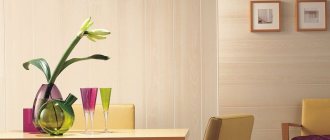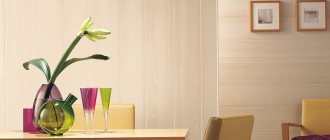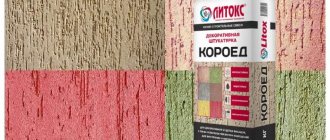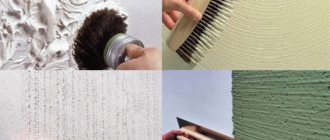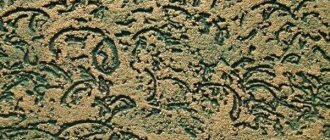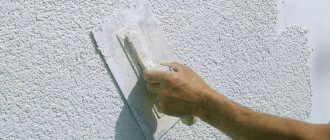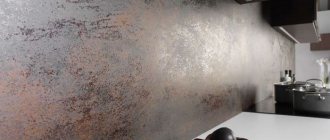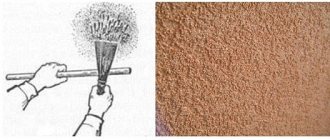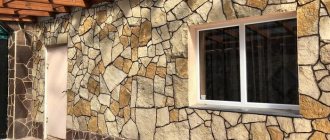Features of the material
Before deciding on plastering work, you should know that “ Bark beetles” come on various bases:
- cement with polymer additives and stabilizers;
- acrylic;
- silicone;
- silicate (liquid glass).
Bark beetles have different bases
Manufacturers provide a choice of dry or ready-made mixtures in buckets with granule diameters from 1 to 3.5 mm. Cement-based bark beetle can be used not only for facades, but also for decorative work inside buildings. It has a number of advantages that you should pay attention to:
- durable, resistant to mechanical stress;
- frost-resistant;
- not afraid of water, snow, hail;
- inexpensive.
The material has many advantages
Disadvantage: dust accumulates in the grooves. Because of this, the facade loses its attractiveness. But it can be washed without fear of damaging or washing off the paint.
Due to its small thickness and light weight, it can be applied to any substrate, even polystyrene boards. Let's look at options and methods for applying this finishing material to building facades.
The larger the size of the granules, the greater the amount of plaster mixture needed per square meter.
Main characteristics
Decorative plaster for walls is distinguished by the presence of the following characteristics:
Mineral filler and polymer elements act as a substitute for sand, which makes the prepared mixture lighter, and this makes it possible to prevent excessive load on the building.
Bark beetle plaster for facades is an environmentally friendly material, since it does not contain any harmful components.
Does not deform in extreme cold or heat (withstands temperature fluctuations from -55C to +60C), is resistant to the effects of the sun, and does not emit components toxic to the human body in extreme heat.
The material is characterized by a long service life, since it is not susceptible to mold, tolerates treatment with weak chemical solutions, the presented products can be easily cleaned with water and not be afraid that the material will deform in heavy rain.
Plaster easily withstands mechanical stress, it can be treated with a sponge or vacuum cleaner, and can withstand light impacts.
As you can see in the photo of decorative bark beetle plaster, its natural color is white, but when mixed with dyes, you can get any shade.
It is widespread and affordable - plaster can be purchased at any hardware store at a very affordable price.
Decorative finishing of external walls
The plaster mixture is intended for finishing the following surfaces:
- brick;
- stone;
- concrete;
- old plaster.
Easy to apply to different surfaces
It is also used for finishing thermal insulation layers made of mineral wool, basalt wool, and polystyrene foam boards over a reinforcing mesh. The only condition for high-quality finishing is a flat surface. Any depressions and irregularities will not allow decorative grooves to be applied to the surface.
There are some nuances regarding coloring, which will be discussed below.
What is better, painting the entire solution at once or painting a plastered wall with paints?
When planning decorative work, you need to understand the advantages and disadvantages of both methods.
Color can be added directly to the solution only in polymer compositions. White cement-based bark beetle is best painted with water-based or acrylic paints after complete hardening. Theoretically, the first method is better. I plastered it once and forgot about it. But it's not that simple.
Subtleties of color choice
If to finish the facade you need to paint 4-5 bags of the mixture at once, then what size dishes are needed and where to get them? Only large construction organizations with the appropriate equipment can afford this. The second problem: how to calculate the exact amount of solution? What happens if one bucket is not enough? It is impossible to guess the exact shade right on the construction site. There is a risk of leaving a stain on the facade for many years.
In most cases, plastered walls are painted with water-based paints after hardening. Economically this is justified.
Types of decorative plaster
Facade plasters (rain, fur coat, bark beetle, etc.) may differ in structure and chemical composition.
The following compositions are in greatest demand:
- Acrylic mixture
. The bark beetle is easy to apply and contains substances that protect the wall from mold and mildew. The plaster is waterproof, allows steam to pass through, and creates a durable, aesthetic layer. Not suitable for rooms with high humidity.
- Silicate
. Often used for external use, the mixture is applied in a thin layer. The main advantages of bark beetle: durability, high level of vapor permeability, dust-repellent properties, moisture resistance, resistance to mechanical stress, ease of maintenance, the mixture does not fade over time. The disadvantages include the high cost and complexity of applying the bark beetle (it is difficult to use the composition yourself without experience).
- Mineral
. The coating removes uneven surfaces and protects the wall from exposure to adverse weather factors. The bark beetle must be applied with a thickness of at least 7 mm (experts recommend making a two-layer version with a thickness of 8 mm). If a 2 mm layer is applied, hail and other mechanical impacts can damage the wall surface.
- Silicone
. The most versatile product that combines the advantages of mineral, acrylic and silicate plasters. The combination of high-quality silicone binder and functional filler provides good protection for the facade. Before applying bark beetle, you should carefully study the technical specifications.
Various types of mixtures are used to decorate the facade, including:
- Terrasite plaster
. Widely used for finishing facades, it is produced on a mineral basis and looks attractive thanks to additives such as marble, glass, etc.
- Mosaic base
. Rarely used for facades. Most often, the mixture is applied to an arch, column, or to emphasize various architectural elements. To ensure that the material remains in good condition, mosaic plaster should be applied after waterproofing.
Other types of coverage:
- bark beetle;
- lamb;
- fur coat.
To insulate exterior walls, vermiculite plaster is often used, which contains a filler called vermiculite. The component enhances the thermal conductivity of the material.
Surface preparation
Preparation of stone, concrete, brick, and other surfaces for finishing is mandatory and requires careful execution. To do this, it is cleaned of dust and oil stains, the cracks are filled, and they are puttied with cement (for exterior) or gypsum mortar for interior work. Particular attention must be paid to searching for peeling old plaster. Such places must be removed and plastered again. clean the surface:
- manually with metal brushes;
- brushes mounted on a drill or grinder;
- sandblasting machine.
Cleaning the surface before work
If the walls are brick, stone, concrete, old, with sinks more than 3 cm deep, then a reinforcing mesh is pulled onto the surface. It is plastered with cement mortar, leveled, puttied, and primed.
Advice from experienced people:
- If an oil stain appears on the wall and it has not penetrated deeply, then it can be removed with a 3% solution of sulfuric acid. This is an ordinary electrolyte for filling batteries. You can buy it at an auto parts store. When diluting, it is necessary to pour the electrolyte into water, and not vice versa! If you confuse it, it is possible that sulfuric acid boils and splashes. This operation is best done with glasses;
- A primer for painting is required. If this is not done, overuse of paint is inevitable.
If necessary, the walls are plastered with cement mortar
Plastering technique
The bark beetle application technology includes several stages:
- Collection of tools and materials.
- Primary preparation of walls.
- Creating layers for plaster.
- Plastering in the desired way to create a certain texture.
- Completion of pattern formation.
- Painting (if necessary).
Decorating walls with bark beetle is a multi-stage process with associated costs. You need to purchase many different materials and tools, some of them in large quantities. The quality of the facade is important, because material consumption and timing depend on it. In order to apply bark beetle, you must first organize an insulating layer and a reinforcing mesh. Then the surface is primed. For this you can use perchlorovinyl, acrylic, alkyd compounds and “concrete contact”. Specifically for monolithic concrete walls, the last option may be the best solution. Facing with bark beetle is carried out taking into account a number of conditions regarding the implementation itself and the state of the environment. The main thing is that the plaster should not dry out before it is evenly applied to the wall. The work should be carried out promptly, covering the surfaces at a time. Using special techniques, complex patterns and designs are created: “travertine”, “cork”, “rain” and even “world map”.
Required materials and tools
To prepare surfaces and then plaster them, you need to collect a lot of tools and materials. To remove the old layer of plaster, you will need a hand chisel (preferably with a guard), a hammer, and a hammer drill with a chisel attachment. When cleaning walls, use a metal brush or a nozzle of the same type. In some cases, a hair dryer will come in handy. It is used simultaneously with a spatula/scraper. Remove dust with a large soft brush or sponge. At the stage of primary surface preparation, a wash can be used. In the future, you will need to acquire all the materials for treating the facade: the bark beetle plaster itself, as well as insulation, paint, leveling mixtures, and primer. The standard set of tools for plastering surfaces includes a mixer attachment, a plumb bob, a level, brushes of various sizes, rollers, a trowel and spatulas of various shapes.
Surface preparation
First of all, the wall is cleaned and leveled. Then thermal insulation is laid. However, if insulation boards were previously installed on the façade, you will need to once again verify the reliability of the fastening. Only then its surface can be reinforced with facade mesh. But immediately before this, the first reinforcing layer needs to be arranged underneath it. A leveling material based on cement-sand mortar is then applied to the mesh. Before applying the primer and bark beetle, you will need to make sure that the previous layer is completely dry. Before the bark beetle, the last primer is applied. To do this, use a brush or roller. The choice of primer should be approached carefully. Perchlorovinyl is suitable for concrete and brick surfaces. They penetrate deeply into the top layer of the coating and provide high adhesion. Alkyd primers are suitable for the above types of surfaces, as well as for any wood. Acrylic compositions are no less versatile than alkyd ones.
Applying bark beetle to the wall
This type of work should be carried out at “plus” temperatures at a time when the part of the facade being processed is in the shade. First, throw the mixture prepared by mixing with water onto the surface. Then smooth the material with a spatula. Round particles in the mixture will leave oblong indentations as they move. Their direction depends on the method of using the spatula. We make all movements carefully and maintaining uniformity, while at the same time working as quickly as possible with the tool - the bark beetle dries quickly. If you adhere to the above principle, you will be able to avoid the appearance of bumps. It should be borne in mind that the presence of inclusions will not allow the layer thickness to be reduced below a certain level. The material can be applied using methods such as circular, rain (up and down movements), and cross (cross movements). Each wall is processed in one approach.
You cannot apply the mixture in large portions, otherwise you may not have time to smooth it out properly and, as a result, get visual defects at the junction of areas saturated with water to varying degrees.
Formation of the pattern
The final drawing is the result of certain movements with a metal spatula or sponge grater. To obtain a classic relief, reminiscent of tracks from a bark beetle, it is necessary to carry out arcuate and circular movements with different vectors. At the same time, the tool is pressed against the wall with half strength. With the help of short jerks with a trowel in different directions, “travertine” is created - an imitation of a rough stone surface. The “cork” pattern is obtained after intensive movements in a circle with a polystyrene foam trowel in the same direction and with a small radius. Cross-shaped movements create the effect of a fabric surface.
Vertical strokes should then be made as slowly as possible, and horizontal strokes should be made with a sharp tangential stroke. The “rain” texture is formed from long continuous lines from the top to the very bottom. There are two options for this design: vertical or diagonal strokes. Adjacent stripes should be different in color.
How to remove old plaster?
It is necessary to remove old plaster only in case of poor adhesion to the base. You need to make sure what type of plaster is: cement or lime? Limescale must be removed without regret. If the cement holds tightly, there is no need to remove it.
Removing old plaster
Tip Check the quality by lightly tapping the wall with a hammer. If the sound is dull, it means the layer has fallen behind the brick base and will fall off over time. Such areas must be removed and plastered again.
Plaster is removed in two ways:
- manually with a chisel, hammer, scraper, spatula;
- mechanical hammer drill or grinder with a diamond wheel.
We resort to using a hammer drill
In both cases it is necessary to get to the base. The final stage is cleaning with metal brushes manually or with a grinder, removing dust with a wet cloth or vacuum cleaner.
Methods for staining bark beetles
Ideally, the same facade paint and color that is present in the plaster itself are used to paint the facade. In this case, even if the painted surface is damaged or peeled off, a dissonant color spot does not form on the façade.
A proven technique for painting bark beetles is to use paint in two shades, for example, pink and red. The first layer is applied with a fluffy roller, which allows you to paint over all the depressions and furrows. After drying, apply two thin layers of lighter colors with a flat rubber spatula. The result is a deep dark base of the facade and a light main bark beetle pattern.
For gray and dark yellow colors, it is very popular to apply an additional layer of acrylic varnish with opalescent or “metallic” shades. Gray takes on the tones of old metal, and yellow becomes like polished sandstone.
Plaster mixture Bark beetle
Before starting plastering work, you must familiarize yourself with the manufacturers' recommendations for preparing the solution. Pay attention to the lifespan. That is, how long will the solution be plastic and workable. Please note that the recommendations indicate the approximate amount of water per kilogram of solution. Each batch may have some difference in the amount of water in one direction or another. Before starting work, you need to make a small amount of solution, a multiple of a kilogram, and weigh the amount of water.
The mixture must be stirred with a low-speed mixer or drill with a speed controller. After the first stirring, you need to leave it for 5 minutes to stabilize and stir again. Stir the mixture in such portions that you can use it completely.
Stir until desired consistency
In most cases, the survival time is about 3 hours. In order not to make a mistake with the amount of mortar and not to make too much, measure how much of it is needed per 1 m2 or how many square meters can be plastered with one bucket.
If the area is large, you will have to use several people. The iron rule of plasterers: one wall must be started and finished without interruption in work.
Advice When calculating the amount of mixture, rely on the manufacturer’s data, but be sure to add 5-10% in reserve.
Which plaster to choose?
Currently, the construction market offers a huge range of bark beetle plasters, since this material is produced by a large number of manufacturers.
Despite this, you need to focus not on the brand, but on the type of mixture, its grain size and the pot life of the finished solution.
Experts consider grain size to be the most important criterion, since it is this parameter that sets the texture of the material and has a significant impact on its consumption.
The thickness of the plaster coating should be equal to the size of the granules, that is, the larger the grain size of the plaster, the thicker its layer, and therefore the higher the consumption.
The next important criterion is the type of composition. Ready-to-use compositions significantly save time, are easier to apply and are more flexible, but they are more expensive than dry mixtures and cannot be stored.
In other words, if the entire volume of plaster was not used at one time, the remainder will have to be thrown away, since the hardened solution will be unsuitable for use.
At the same time, dry mixtures are much cheaper, and they can be prepared in the required volume - while the remainder of the dry material is perfectly stored in hermetically sealed packaging.
The only difficulty may be preparing the correct solution, but if you follow the instructions exactly, then the process of mixing the composition will not cause any difficulties.
Technology of applying facade plaster
There is nothing complicated about the application technology. The marble chips themselves will regulate the thickness of the application. To apply you must have:
- stainless steel grater or spatula;
- plastic grater.
Choosing material for work
When applying the solution, the metal float should be held at an angle of about 45 degrees. Each master chooses the angle of inclination for himself.
Adviсe:
- the solution should have such a consistency that it does not slide off the grater;
- the solution must be applied without effort;
- do not take breaks until you have covered the entire wall with the mixture;
- From time to time, check the readiness of the mixture for making indentations with a plastic grater from granules.
Drying time for the plaster mixture is at least two days.
After application, let dry
Getting different effects
When the decorative plaster mixture begins to dry out, you can begin to apply the design. The marks are applied vertically, horizontally, at an angle or in a circular zigzag motion, trying to achieve a resemblance to the passages of a bark beetle in a tree.
Adviсe:
- if you start making vertical stripes from top to bottom, then you cannot change the direction to the opposite from bottom to top;
- the same goes for horizontal, circular and zigzag movements.
Under no circumstances do we change direction.
You can start drawing only after it dries. It is difficult to determine how much time is needed accurate to the minute. But there is one caveat. When the mixture dries, it decreases in volume, and small granules protrude above the surface. As soon as the grout stops clinging to the entire surface with its sole, you can begin.
"Rain Jets"
This is the simplest but most effective way of applying a pattern to the facade. It is done by vertically sliding a grater from top to bottom. The “length of the jets” is adjusted by the plasterer. Here you need to adhere to strictly vertical movements.
Method "Vertical rain"
The higher the house, the larger the size of the granules.
"Slanting Rain"
These are the same “Rain Jets” only from a certain angle. This effect is more complicated than the previous one because you must strictly adhere to the once chosen angle.
“Slanting Rain” Method
Before you start using this effect, you must first try it on a separate surface to decide whether this method of decoration is suitable for your object or not.
"Bark beetle"
This is the simplest effect, it is not difficult to perform. To do this, you need to move the plastic grater randomly in all directions.
Achieving the effect using grout
For home use, you should not take a mixture with granules smaller than 3 mm. Granules that are too small will not give a good visual effect at altitude. The grooves will be barely noticeable.
"Horizontal bark beetle"
Although such effects are most suitable for interior work, they are quite appropriate for implementing design ideas.
Horizontal option
When using this effect, the main condition is not to deviate too much from the horizontal.
Two-colored bark beetle
This is a more complex and expensive method of applying plaster in two shades. There are two ways to achieve this effect.
First. Adding color to the solution and preparing the colored base at the first stage. The next step is to paint the protruding surfaces with a different color using a short-nap roller.
The second method is to first paint the entire wall with a long-nap roller. It is necessary to ensure that all recesses (paths of the woodworm) are painted. At the second stage, the protruding surfaces are painted with a short-pile roller.
Use of two-color bark beetle
Thus, the recesses will be one shade, and the overall tone will be different.
For finishing the exterior of a house, “Bark Beetle” fits perfectly. It should be noted that when selecting shades for painting, there is a rule. No more than three colors should be used. In exceptional cases, four. Moreover, the fourth shade should be no more than 5% . These could be window frames, protective strips on the roof.
The foundation must be in harmony with the roof. If you cannot find a suitable foundation color that matches the roof, then use contrasting or neutral colors.
Harmony of foundation and roof
His Majesty neutral gray color harmonizes with almost all shades. See how the color scheme was chosen to decorate the walls of a residential building.
Pay attention to the almost complete match of the shades of the foundation with the roof. Painting the walls white and light green.
Classic design in three colors
There are a lot of options for choosing decorative solutions. After finishing the finishing work, impregnate the facade with a water-repellent composition. This procedure will protect the walls from the destructive effects of moisture and low temperatures for many years.
How to apply bark beetle
Ease of work is one of the main advantages of bark beetle, because such plaster is easy to apply yourself. But first you will have to prepare the surfaces: remove old paint, sand, clean. Prime the walls or treat them with special antiseptics to prevent fungus.
Patch up large defects on the surface with ordinary gypsum putty. You don’t have to strain yourself too much here, because the bark beetle will hide minor flaws. If the difference in height along the wall is too large, it is better to level it, otherwise the textured coating will only emphasize it.
Apply an acrylic primer as the first layer for strong adhesion and elimination of excess moisture. The recommended thickness of the bark beetle layer corresponds to the filler fraction. During the process, this can be seen visually as soon as the first furrows begin to appear. Use a special grater or spatula at an angle of 60 degrees.
For façade finishing, the preparation is slightly different, so first you need to lay a reinforcing mesh on the insulation. Wait a day for it to stick firmly, and only then proceed to priming and plastering.
Remember that textured plaster sets quickly, so you need to work quickly and without interruptions. Do not apply the mixture to any old coating - it is not durable. And don’t do finishing if the temperature is below 5 degrees.
Depending on how you distribute the plaster, you will get different patterns. These can be vertical or horizontal stripes, chess, frost, cork and others. The bark beetle takes up to 3 days to dry, depending on humidity and temperature.
If you want to paint the top of the plaster, you need a textured roller with fine pile, for example, made of velor. It will get into all the furrows well, so you don't even need to press hard. And with multiple shades, you can create a vibrant two-tone paint job just by varying the roller pressure.
MDF: what is it? Types and features of material
Interior decorative finishing of the house
Designers are looking for new ideas for interior decoration. “Bark beetle” is a textured plaster, characterized in that it:
- has a unique textured pattern;
- strong, durable;
- Can be repainted with different colors many times.
Great resistance to abrasion and the ability to wash walls from dirt make its use in rooms with a large number of visitors quite justified. Small pebbles of the same diameter create bizarre, unique grooves.
Interesting idea for interior decoration
Decorative stone-like plaster goes well with wood and drywall. Small sections of the wall or a completely plastered room with “Bark Beetle” is practical and modern. The use of matte paints, painting in two colors, creates an imitation of the bark of different types of wood. Acrylic or plaster compositions are suitable for decorating a bedroom, bath, children's or living room.
Bark beetle plaster: photo examples of beautiful houses
The great popularity of the bark beetle is due to its unique decorative effect, high resistance to weather conditions and long service life, which reaches 25 years without loss of surface texture and color. The quality and relevance of this finishing method is also evidenced by the fact that bark beetle is often used as plaster for the facades of houses in Europe. Photos of houses with external walls of a similar plan are presented below.
Peculiarities
For interior work, the industry offers ready-made mixtures:
- acrylic;
- silicate;
- silicone;
- polymer cement.
Only polymer-cement compositions are sold in dry form. They must be prepared before use. To do this you need a low speed mixer, a bucket, and water. The main condition for high-quality plaster is a clean and smooth wall. To work, you need a stainless steel float and plastic grout.
It is important that the wall is level
Hallway decoration
To create a unique interior, it is not necessary to plaster the entire room. It is enough to select one or more walls. In order for the room to look aesthetically pleasing, it is necessary to remember that the “Bark Beetle” is not suitable for every style. For a small hallway, you should take into account the following: vertical stripes make the room higher, and horizontal stripes lower.
Tip When selecting colors, try to use no more than three. The hallway is where guests find themselves. In most cases, it does not shine with large areas and natural light. Therefore, when decorating the hallway, it is recommended to use warm pastel colors: beige, light brown, light orange.
Try to choose colors that are not too bright
Decorating the hallway in the “Loft” style
This style of room decoration seems primitive, but in terms of design costs it is one of the most expensive. The more the room resembles a workshop or utility room, the cooler the design. The texture of the wall with deep grooves is what the Loft lacks.
A room that looks more like a utility room
Bathroom finishing
This plaster mixture is very resistant to wet conditions and its use for bathroom decoration is quite justified. But it should be remembered that “Bark beetle” is not a ceramic tile. The bathroom should have good ventilation. The walls must be completely dry after moistening.
A good combination of shades for the bathroom
When plastering, consider the material of the base of the walls: stone, concrete, brick or plasterboard. If the walls are plasterboard, they must first be plastered with cement mortar over a reinforcing mesh. The bathroom has many plumbing fixtures plated with chrome or nickel . Therefore, the Techno style is best suited. Walls covered in two tones using metallic shades will highlight the Techno style in the bathroom.
Bark beetle in the bedroom
In order to make an original bedroom design, it is enough to plaster one of the bedroom walls in a minimalist style.
Minimalist style for the bedroom
Advice To decorate rooms inside a building, it is recommended to use acrylic, silicone or silicate plasters, which are ready for use immediately in buckets. You just need to add color and stir gently.
Silicone is the most expensive, but its performance qualities offset the high price . After drying, the surface becomes shiny and will last for decades.
Chalet style bedroom
Unusual, practical and affordable
To decorate a bedroom in a rustic style, it is enough to decorate one wall with a textured layer. The bark beetle will come in handy in this case.
The rustic style is characterized by:
- a lot of wood;
- stone;
- textured plaster;
- fireplace.
The wall made of stone blocks near the fireplace looks interesting, the surface of which is eaten away by a bark beetle . Local lighting of the surface will cast fancy shadows, emphasizing the relief structure.
In the living room
The living room is the central room in the house. Family gathers here for the holidays and receives guests. This room should be a source of pride for the owners. Smooth, white walls have long been out of fashion. The textured surface of the walls will help add zest to the design of the room.
A highlight in the design of the living room
Pay attention to the use of local lighting to accentuate the plastered wall. The living room should have a festive look, so it is recommended to paint it in two colors. When painting, there are two options: the base color is light or dark. It all depends on taste. The second color should be contrasting to the first.
Tip: To focus the attention of guests on some art object, decorate a small panel in the center of the wall. Here you can hang a bright painting or photograph and the living room in the art deco style is ready.
Examples of small and large rooms
Bark beetle plaster in the corridor also has a right to exist. The corridors in the apartments are not very wide. Sometimes it is difficult for two family members to stretch in a narrow space. There is always a risk of rubbing yourself against the wall. The bark beetle is so strong that repeated touching is of no use to it.
Tip To keep this small room looking fresh all the time, leave some paint after finishing and touch up worn areas on the walls from time to time.
Decoration of the staircase
This is the structure you get if you combine horizontal and vertical movements. To obtain a more vivid effect, it is necessary to use mixtures with filler with a diameter of at least 3.5 mm.
At the finish line
After drying, the coating is treated with sandpaper. For acrylic plaster with dye, this is where all manipulations end.
Cement-based plaster is additionally painted to enhance its decorative effect. It is better to do this with water-soluble acrylic or silicone paints. The walls are cleaned of dust remaining from sanding and covered with a layer of deep penetration primer. Painting is done in 2 layers: first with vertical, then horizontal strokes.
Tip: a proven technique when painting this type of decorative plaster is a combination of 2 shades, for example, pink and red. For the first layer, a fluffy roller is good, painting over all the irregularities. Then a thin rubber spatula is used to create two layers of a lighter tone. The result is a non-standard façade color scheme.
The peak of popularity of this decorative plaster has not yet passed. It has many prospects that will unfold as individual housing construction develops.
The role of lighting to enhance decorative effects
When using “Bark Beetle” for decorative wall decoration, no matter where it is located outside or inside, do not forget about lighting. Lighting can be:
- general (chandelier in the living room);
- local (floor lamps, sconces);
- accent (swivel lamps that focus attention on the object).
By using lower light from lamps located on the floor, you can achieve two-level illumination of the object of interest.
Lighting niches and openings plastered with bark beetles allows you to highlight the opening and add volume to the room. Hidden light illuminating an interesting art object adds mystery to the design.
Some tips:
- to increase the volume of the room, direct the light from the lamps to the walls;
- to make the ceiling higher, remove the chandelier from the center of the room and place the lamps around the perimeter;
- the use of sconces adds volume to the room;
Add volume to the room through lighting
Using lighting to create an original design, you can hide imperfections, expand or reduce the size of the room, and focus attention on objects that are important to the owners:
- photos;
- paintings;
- vases;
- antique objects.
Lighting is a powerful design tool to create a stylish interior without resorting to major renovations for little money.
How to choose the right insulation thickness
In order not to make a mistake with the choice of insulation thickness, you should use special programs. For example, there are calculators online for calculating the thickness of thermal insulation. One of them is here. It takes into account many parameters, and even relies on the climatic conditions of various Russian cities.
The proposed fields must be filled in, indicating the desired temperature in the room, the type of room and structure, and the dimensions of the building. By clicking the “perform calculation” button, the program will display the desired figure.
In general, there are standards for each region.
· Moscow – 120 mm
Chelyabinsk – 130 mm
Kemerovo – 140 mm
· Sochi – 90 mm.
Combination of colors in the interior
The fact that color affects mood and physiological functions of a person has been proven by scientific research. Before you start plastering rooms with Bark Beetle, you need to take into account the color effect of the furniture and other objects in the room. Of course, personal taste preferences will play a major role, but the advice of scientists should also not be neglected. This issue has been studied for a long time; there are special color combination tables for designers.
Shade combination table
The first color is dominant, and the rest are complementary, harmoniously combined with the main one.
Textured plaster in its appearance resembles stone, so designers use it in those styles where stone materials are required.

